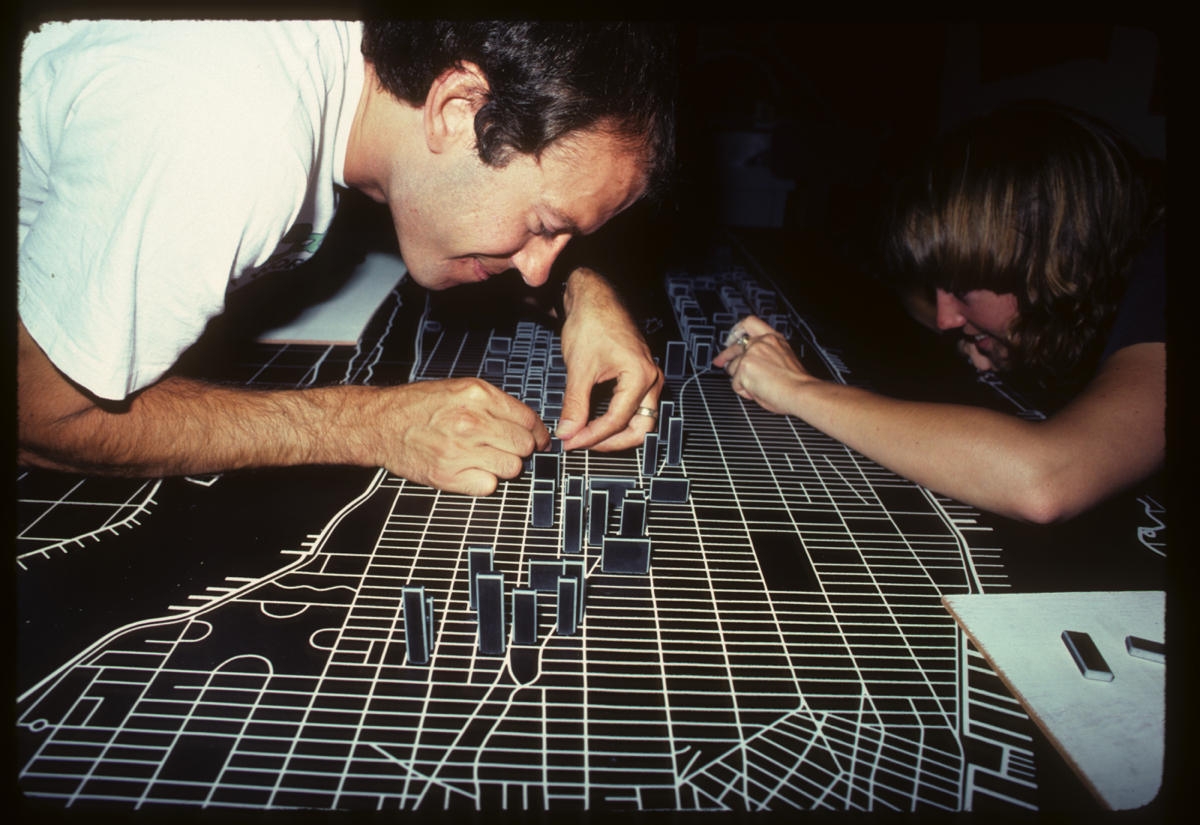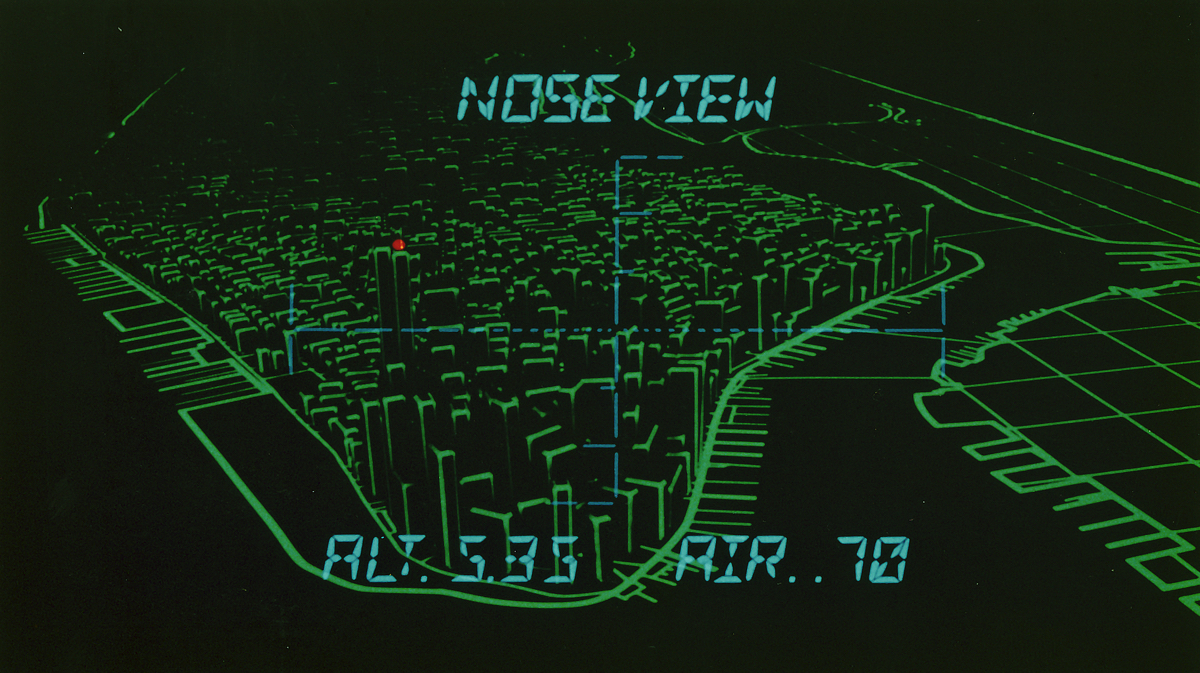The model build behind those simulated computer wireframes.
Recently, Escape From New York celebrated its 40th anniversary. There’s a plethora of effects in John Carpenter’s 1981 film, including that moment when Snake (Kurt Russell) lands a glider atop the World Trade Center. As he approaches the building, a 3D-type topographical view of New York City appears on screens. These were actually simulated computer wireframes extrapolated from practical model builds, overseen by John Wash.
I talked to Wash for issue #2 of befores & afters magazine for the story that dove deep into wireframes. Since the film now has its four decade anniversary, I thought I’d also share here the full interview we did, plus some amazing behind the scenes images of the model build.
b&a: Why do you think wireframes back then, and still today, do such a great job of communicating ‘CG’ and ‘computer vision’?
John Wash: Back in the nascent era of computer graphic imagery, a wireframe image was the sole method of representing geometry on a screen. The computers of that time had limited resources, both in computing power and memory. Wireframe renderings were a means of taking advantage of limited computing power. Even today, as well as back in the 1960’s, a wireframe image appears as “computer generated” to most any viewer.
Wireframes also bring to mind a technical style similar to the drawing that a draftsperson would create. To me what is fascinating is that the wireframe imagery simultaneously is simple in terms of its abstract form, and advanced, in that wireframes are drawings made by computing machines.

b&a: Do you remember your thought process for thinking about how this approach to the wireframe view would work? How confident were you it could work? How did the test help you prove it could be done?
John Wash: My background was in graphic animation, and I had used back-lit artwork manipulated under an animation camera to create imagery that looked like it was computer generated. The techniques I mastered allowed me to generate sophisticated animation, even beyond the capabilities of the computers at the time. This began with work I did on “Dark Star”, the first film in which I collaborated with John Carpenter. I had done similar animation on “Star Wars: Episode IV – A New Hope”, completing the final shot in a sequence that Larry Cuba had animated on a computer. In the film, the animated sequence is shown on a large display in the rebel base briefing room. There the pilots are shown where to drop proton torpedoes that would destroy the Death Star.
For my assignment on “Escape from New York”, I knew, from the challenges that Larry had faced earlier, that creating the entire island of Manhattan as a three dimensional computer animation would be cost prohibitive, if even possible. And cost was a consideration, since part of the reason Carpenter had asked me to do the sequence as a graphic animation was to spare the expense of doing more costly photo-realistic visual effects shots.

My inspiration for the technique I used again came from working on “Star Wars”. Jay Teitzell and I made use of a prop which was designed as a technical model of the fourth moon of Yavin, home to the rebel base. It was a sphere, actually a classroom globe of the earth, that was painted white, and illustrated with contour lines and other techno-gibberish. When flatly lit and photographed using high contrast black and white film, the globe retained its characteristic shape, but was given a level of abstraction, as if it had been generated by a computer. I reasoned that if I could build a similar model of Manhattan out of high contrast black and white solids, I could achieve a convincing mimicry of a computer -generated wireframe.
I started out with a simple test, shooting a move on a white cube with black edges on hicon film under an animation camera. The results were encouraging, and I began working with Mark Stetson on a second test. Another test was needed, since I was not certain if a model containing more than a thousand such rectangular solids would give me the photographic result I was after. Would reflected light from one solid to another be a problem? Also, the question of image polarity was an unknown. Should we build white buildings with black edges, or black buildings with white edges? To build our test model, Mark came up with an ingenious construction technique—each “building” was a small block of plexiglas (i.e. Perspex). In the case of the black buildings, the block was white, and coated with black paint.

Mark then used a small router to cut tiny channels in the edges of each block, revealing the white plastic below the black surface. The reverse was used for the white blocks. Mark built up a small section of the Manhattan model, and his wife Leslie, who worked as a photographer, shot stills of it. The mock-up was mostly white buildings, but we did include a few black buildings off to one side. It was fortunate we did this, since the black blocks clearly won out as the most photogenic for my purposes. Armed with good knowledge from our analysis of this small model, I engaged Mark to build the full model of Manhattan, as well as larger models of Park Avenue, and the World Trade Towers for the second half of the sequence.
b&a: When the film came out, do you remember anyone asking you or talking about whether maybe those POV wireframe shots *were* done in the computer? Any hesitations about revealing how they were done?
John Wash: I do remember of someone, I can’t remember who, writing about the “Escape from New York” in an internet article, and critiquing my sequence as computer-generated animation. It was really quite gratifying to know that my work had convinced at least one person. I don’t think of my work, especially in this instance, as “fooling” any viewer. After all, motion pictures, in of themselves, are a complete illusion, creating motion from a series of still images. The persistence of vision is a remarkable phenomenon. One of my favorite enigmas was that during the screening of a movie on film, thanks to the 180 degree shutter on the projectors of old, the audience was sitting in a completely dark room for half of the presentation!














